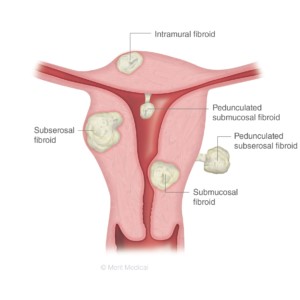Learn More About
the Many Symptoms of Fibroids
COMMON SYMPTOMS ASSOCIATED WITH UTERINE FIBROIDS.
Excessive Menstrual Bleeding
EXCESSIVE MENSTRUAL BLEEDING
Learn MorePELVIC PAIN AND PRESSURE
PELVIC PAIN AND PRESSURE
Learn MoreFREQUENT URINATION
FREQUENT URINATION
Learn MoreOTHERS SYMPTOMS
OTHERS SYMPTOMS
Learn MoreExcessive menstrual bleeding is one of the most common symptoms of uterine fibroids. It is also the most prevalent symptom for two out of the four types of uterine fibroids: intramural and submucosal. When experiencing uterine fibroid symptoms like heavy menstrual bleeding or abnormal uterine bleeding, there are other symptoms that directly result from it. (other symptoms directly result).
Passing clots is very common with excessive menstrual bleeding as well as prolonged cycles of bleeding and longer monthly periods. It can also cause frequent soiling, something that can interfere with everyday activities and lifestyle. Abnormal uterine bleeding that is prolonged can have serious side effects over time. Untreated, it can lead to fatigue and anemia, which is the result of a low red blood cell count. These factors can eventually lead to the need for blood transfusions.
Pelvic Pain and Pressure
As fibroids grow they can put additional pressure on surrounding organs, which can be extremely painful. The growth of fibroids can cause consistent lower abdominal pain as well as swelling, which is sometimes mistaken for weight gain or pregnancy. If you are experiencing pelvic pain and pressure or any other type of uterine fibroid symptom, a full gynecological exam should be done immediately to determine the cause.
Pelvic pain and pressure can be caused not only by the size of a uterine fibroid tumor but also the location. Additional conditions can accompany uterine fibroids, such as adenomyosis and endometriosis.
Adenomyosis occurs when the tissue that lines the uterus (endometrium) grows within the middle layer of the uterine wall and supportive vascular tissue (myometrium). Typically, the uterine lining prevents adhesions (bands of scar-like tissue) from occurring. However, when uterine fibroids develop and begin to grow, the possibility for adhesions also grows something that can cause a great deal of pain.
Endometriosis occurs when the endometrial tissue is found outside of the uterus and can be another painful and uncomfortable condition occurring along with uterine fibroids. Again, in order to properly diagnose uterine fibroids and effectively determine the cause of these symptoms, a full gynecological exam should be performed.

Urinary Incontinence and Frequency (Loss of Bladder Control)
One of the organs commonly affected during the growth of uterine fibroids is the bladder. As added pressure is applied to the bladder, the risk of urinary incontinence, or the loss of bladder control, as well as frequent urination increases. Not only can this cause a great deal of pain and discomfort, but it can also become a hindrance in everyday activities.
Another possible effect of uterine fibroid growth can be increased pressure on the bowel. This can cause uncomfortable constipation and/or bloating. If you feel you are experiencing these potential fibroid symptoms on a regular basis, consult with a medical professional in order to rule out or diagnose any potential serious medical conditions.
Other Symptoms
- Anemia
- Pain in the back of the legs
- Pain during sexual intercourse
- Constipation
- An enlarged abdomen
Depending on the size and location of fibroids, symptoms can become so severe that they affect the ability to maintain daily activities. However, many women live with fibroids and still maintain a good quality of life with the ability to manage and perform their everyday tasks. In some cases, women may experience no symptoms at all.
If you are experiencing signs and symptoms of uterine fibroids and are finding it difficult to perform your daily activities and maintain your way of life, you should contact your local interventional radiologist immediately.

